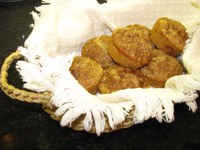Prairie Fare: Tasting Cookie Dough is Hazardous for New Reasons
(Click an image below to view a high-resolution image that can be downloaded)
By Julie Garden-Robinson, Food and Nutrition Specialist
NDSU Extension Service
Do you ever taste cookie dough? Licking the mixing spoon or pinching a chunk of batter from the bowl can be tempting.
If you said “yes, I taste raw cookie dough,” give yourself a pat on the back for your honesty. Now I need to tell you to avoid the temptation of tasting raw doughs and batters and take some extra precautions when baking.
Do you know why food safety experts say you should not eat cookie dough? Are you thinking about raw eggs? Yes, raw eggs may contain salmonella, a type of bacteria that can make you very ill. Pasteurized eggs, on the other hand, have been heat-treated to make them safe to use in raw or lightly cooked foods.
However, eating doughs can be hazardous to your health for other reasons beyond the raw eggs.
Recently, I attended a conference where the Home Baking Association had an educational booth. Association members were eager to relay some important information to all of us regarding raw flour, and unbaked and underbaked doughs and batters.
Flour is considered a “raw food” because it is not heated prior to being placed in bags at the mill. Heating flour would affect the protein and, as a result, the baking properties.
While most people are aware of the hazards associated with eating raw meat and eggs, the concern about safety issues associated with raw flour arose fairly recent.
Flour and some other grain-based foods have been linked to E. coli and salmonella outbreaks in the U.S., Canada and other countries. In one outbreak, 80 people were sickened as a result of eating refrigerated ready-to-bake cookie dough. Tasting cookie dough is not worth the risk.
For example, E. coli O121 can result in abdominal cramps, bloody diarrhea and kidney damage. Foodborne illnesses may result in death, especially among young children, older adults and those with compromised immune systems.
As a result of the foodborne illness outbreaks and recalls associated with flour, be sure to pay attention to these safety tips when baking:
- Store flour, baking mixes and eggs separately from ready-to-eat foods.
- Examine your recipes and check if they call for flour that is not heated prior to serving. Use a different recipe if your recipe does not require a baking or cooking process.
- Avoid recipes for children’s playdough that include uncooked flour. Children may taste the dough. Many recipes are available, so use one in which the ingredients are cooked and then cooled prior to use.
- Don’t cross-contaminate. Keep the bowls and utensils used for eggs, raw batter or dough away from the cooling rack and away from the finished baked products.
- Be cautious after kneading bread dough. Wash your hands with plenty of soap and water. Wash the surfaces, measuring tools and other items carefully.
Use your food thermometer when cooking high-protein foods, such as meat and poultry. Take out your thermometer when you are baking, too, according to the latest recommendations. These are the internal temperatures recommended for various baked goods:
- 150 F - Cheesecakes (Remove at 150 F to avoid cracking. The temperature should rise to 160 F as it cools.)
- 160 F - Quiche, meringue pies, bread pudding, baked custard, flan, molten chocolate cakes
- 165 F - Chocolate cream pie; stuffing; meat-, cheese- or poultry-filled breads, pot pies, calzones and others
- 170 to 175 F - Custard pies, fruit pies, flan, creme brulee
- 190 to 210 F - Yeast rolls (190 F), crusty bread (210 F)
- 200 to 209 F - Most cakes, cupcakes, quick breads, scones, biscuits, pecan pie
After baking, cool baked goods on a wire rack. Refrigerate cream-based, egg-rich or meat-filled baked goods.
Here’s a favorite muffin recipe that makes use of autumn’s favorite fruit: apples. For more recipes featuring the fruits of the region, check out the “Windbreak Cookbook,” an award-winning cookbook available on the NDSU Extension Service website (https://www.ag.ndsu.edu/food).
Oatmeal and Apple Muffins
1 c. quick-cooking oatmeal
1 c. buttermilk
1 egg, beaten
1/2 c. brown sugar
1/4 c. canola oil
1 c. all-purpose flour
1 tsp. baking powder
1/2 tsp. baking soda
1/2 tsp. salt
1 tsp. cinnamon
1/2 c. apple, diced, not peeled (about 1 small apple)
Optional topping (1 Tbsp. sugar and 1/4 tsp. cinnamon)
Preheat oven to 400 F. Mix oatmeal and buttermilk in a large bowl and allow to stand for 15 minutes. Add beaten egg, brown sugar and oil to the oatmeal mixture. In a separate bowl, mix flour, baking powder, soda, salt and cinnamon. Add the dry ingredients to the wet ingredients and mix just until combined. (Overmixing may result in lower-quality muffins with peaked tops and tunnels). Finally, gently stir in the apples. Spray muffin tins with nonstick spray (or use oil to grease them). Fill the muffin cups about two-thirds full of batter. Sprinkle the tops with cinnamon-sugar mixture. Bake for 15 to 18 minutes, until lightly browned and a toothpick comes out clean. According to the latest information, use a food thermometer to be sure the internal temperature reaches 200 F.
Makes 12 servings. Each serving has 160 calories, 6 grams (g) fat, 4 g protein, 24 g carbohydrate, 1 g fiber and 230 milligrams sodium.
(Julie Garden-Robinson, Ph.D., R.D., L.R.D., is a North Dakota State University Extension Service food and nutrition specialist and professor in the Department of Health, Nutrition and Exercise Sciences. Follow her on Twitter @jgardenrobinson)
NDSU Agriculture Communication - Oct. 26, 2017
| Source: | Julie Garden-Robinson, 701-231-7187, julie.garden-robinson@ndsu.edu |
|---|---|
| Editor: | Ellen Crawford, 701-231-5391, ellen.crawford@ndsu.edu |



